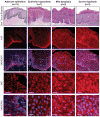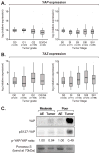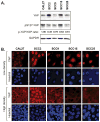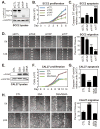A YAP/TAZ-Regulated Molecular Signature Is Associated with Oral Squamous Cell Carcinoma
- PMID: 25794680
- PMCID: PMC4470857
- DOI: 10.1158/1541-7786.MCR-14-0580
A YAP/TAZ-Regulated Molecular Signature Is Associated with Oral Squamous Cell Carcinoma
Abstract
Oral squamous cell carcinoma (OSCC) is a prevalent form of cancer that develops from the epithelium of the oral cavity. OSCC is on the rise worldwide, and death rates associated with the disease are particularly high. Despite progress in understanding the mutational and expression landscape associated with OSCC, advances in deciphering these alterations for the development of therapeutic strategies have been limited. Further insight into the molecular cues that contribute to OSCC is therefore required. Here, we show that the transcriptional regulators YAP (YAP1) and TAZ (WWTR1), which are key effectors of the Hippo pathway, drive protumorigenic signals in OSCC. Regions of premalignant oral tissues exhibit aberrant nuclear YAP accumulation, suggesting that dysregulated YAP activity contributes to the onset of OSCC. Supporting this premise, we determined that nuclear YAP and TAZ activity drives OSCC cell proliferation, survival, and migration in vitro, and is required for OSCC tumor growth and metastasis in vivo. Global gene expression profiles associated with YAP and TAZ knockdown revealed changes in the control of gene expression implicated in protumorigenic signaling, including those required for cell cycle progression and survival. Notably, the transcriptional signature regulated by YAP and TAZ significantly correlates with gene expression changes occurring in human OSCCs identified by The Cancer Genome Atlas (TCGA), emphasizing a central role for YAP and TAZ in OSCC biology.
Implications: This study defines a YAP/TAZ-regulated transcriptional program in OSCC and reveals novel roles for nuclear YAP/TAZ activity in the onset and progression of this cancer.
©2015 American Association for Cancer Research.
Conflict of interest statement
The authors have no conflict of interest to disclose
Figures







Similar articles
-
YAP signaling induces PIEZO1 to promote oral squamous cell carcinoma cell proliferation.J Pathol. 2021 Jan;253(1):80-93. doi: 10.1002/path.5553. Epub 2020 Nov 5. J Pathol. 2021. PMID: 32985688
-
Targeting YAP/TAZ-TEAD signaling as a therapeutic approach in head and neck squamous cell carcinoma.Cancer Lett. 2025 Mar 1;612:217467. doi: 10.1016/j.canlet.2025.217467. Epub 2025 Jan 16. Cancer Lett. 2025. PMID: 39826667
-
Manganese drives ferroptosis of cancer cells via YAP/TAZ phase separation activated ACSL4 in OSCC.Oral Dis. 2024 Nov;30(8):4898-4908. doi: 10.1111/odi.14925. Epub 2024 Mar 10. Oral Dis. 2024. PMID: 38462885
-
Multifaceted regulation and functions of YAP/TAZ in tumors (Review).Oncol Rep. 2018 Jul;40(1):16-28. doi: 10.3892/or.2018.6423. Epub 2018 May 8. Oncol Rep. 2018. PMID: 29749524 Free PMC article. Review.
-
New insights into YAP/TAZ nucleo-cytoplasmic shuttling: new cancer therapeutic opportunities?Mol Oncol. 2019 Jun;13(6):1335-1341. doi: 10.1002/1878-0261.12498. Epub 2019 May 17. Mol Oncol. 2019. PMID: 31050214 Free PMC article. Review.
Cited by
-
Cytoplasmic LIF reprograms invasive mode to enhance NPC dissemination through modulating YAP1-FAK/PXN signaling.Nat Commun. 2018 Nov 30;9(1):5105. doi: 10.1038/s41467-018-07660-6. Nat Commun. 2018. PMID: 30504771 Free PMC article.
-
The deubiquitinase USP7 promotes HNSCC progression via deubiquitinating and stabilizing TAZ.Cell Death Dis. 2022 Aug 5;13(8):677. doi: 10.1038/s41419-022-05113-z. Cell Death Dis. 2022. PMID: 35931679 Free PMC article.
-
Yes-associated protein-1 overexpression in ocular surface squamous neoplasia; a potential diagnostic marker and therapeutic target.Front Oncol. 2023 Jul 5;13:1213426. doi: 10.3389/fonc.2023.1213426. eCollection 2023. Front Oncol. 2023. PMID: 37476371 Free PMC article.
-
The Hippo component YAP localizes in the nucleus of human papilloma virus positive oropharyngeal squamous cell carcinoma.J Otolaryngol Head Neck Surg. 2017 Feb 22;46(1):15. doi: 10.1186/s40463-017-0187-1. J Otolaryngol Head Neck Surg. 2017. PMID: 28222762 Free PMC article.
-
Inhibition of LSD1 epigenetically attenuates oral cancer growth and metastasis.Oncotarget. 2017 Jul 27;8(43):73372-73386. doi: 10.18632/oncotarget.19637. eCollection 2017 Sep 26. Oncotarget. 2017. PMID: 29088714 Free PMC article.
References
-
- Varelas X, Kukuruzinska MA. Head and neck cancer: from research to therapy and cure. Annals of the New York Academy of Sciences. 2014;1333:1–32. - PubMed
-
- Harvey KF, Zhang X, Thomas DM. The Hippo pathway and human cancer. Nat Rev Cancer. 2013;13:246–57. - PubMed
-
- Camargo FD, Gokhale S, Johnnidis JB, Fu D, Bell GW, Jaenisch R, et al. YAP1 increases organ size and expands undifferentiated progenitor cells. Curr Biol. 2007;17:2054–60. - PubMed
Publication types
MeSH terms
Substances
Grants and funding
LinkOut - more resources
Full Text Sources
Medical
Molecular Biology Databases
Research Materials

